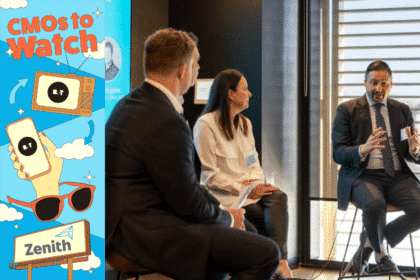Will Feutrill is Blackhawk Network’s customer insights and strategy director. He sat down with B&T to discuss his work, and the power of rewards on consumer relationships.
Blackhawk Network is a world-leading branded payments company, developing egifts, gift cards and rewards to connect brands with their consumers.
In his role as customer insights and strategy director, Feutrill specialises in understanding what consumers are looking for.
B&T: What does your role as customer insights & strategy director involve?
WF: My day to day role is to look to understand each of our clients’ customer life cycles, and then use whatever data we’ve got around that to identify the key moments of truth. Within those key moments of truth, there might be moments of churn or acquisition triggers or opportunities to upsell or cross sell. Then we will use our solutions to map against those to influence the customer behavior.
So, ultimately, if we can achieve the customer shift in behavior, then we can help out our clients’ businesses grow. That’s essentially what we do. It’s an interesting position to be in, because it means that we have a broad understanding of the customer lifecycle across almost every industry that we touch.
How diverse are the industries who use egifts and rewards?
We’ve got everything from George Weston Foods. right through the financial services industry with Westpac and ANZ and HSBC, Citibank. Then something like insurance is a very different purchase. We’vealso got retail clients in Harvey Norman.
There’s a lot of different customer journeys: you’ve got short life cycles, you’ve got long life cycles, and then even within one of our clients, the portfolio is very different. So a credit card customer at a bank looks very different from a home loan customer. Additionally, you also need to understand how they flow in between, so a credit card customer will become a home loan customer.
It’s really creative problem solving. That’s part of the difference of what we look at in the market – we try and look at it holistically rather than just looking at what is the incentive that’s going to change the behavior that’s already predefined?
How have you adapted your work through the challenges of the last year?
Blackhawk acquired two companies in November of 2019., Edge Loyalty and Digital Glue. We shoved them all together [with the traditional Blackhawk business], and then said, “alright, we’re going to try and mix three different sets of technologies, three different processes, three different cultures, mash them all together”.
And then we all went to working from home – so it was a big challenge!
We moved offices in that space. I’ll tell you, we’ve still got plastic bags of people’s stuff off their desk, that we just dumped on a desk, the screens aren’t set up right. That’s just the way it’s been in Melbourne. [That being said] we’ve almost defined our working practices during the pandemic. With that much change it gave us an opportunity to review across everything, what was working and what wasn’t. We had to be really critical in our processes and our internal structures.
In some ways, I think we’re actually going to come out better because of that. Because of the restraints of the of the pandemic, we’ve had to be more efficient, we’ve had to be clearer in the processes and clearer in our expectations.
One of the one of the things that I’ve been amazed at with my team in particular is we’ve got a lot of mums and dads who are working from home with kids climbing all over them, and trying to fit in work around that and homeschooling. I think you get a unique insight into the individual that you wouldn’t have got if you were all in the office. I was reflecting on this, about a week ago, the care and the support that the team have wrapped around each other. We’ve seen so many people take on roles that aren’t necessarily directly in their line of work, to help the business and to help each other.
Ultimately, we are a better and more connected business in that way. But I’ll tell you what, I’m looking forward to a Friday afternoon pub session!
Has the pandemic increased customer receptivity to rewards and egifts?
We’ve been fortunate enough through the pandemic that the demand for rewards hasn’t gone away. I think there’s probably two dimensions here: the first is obviously the hardship that people are going through. The pandemic has had a real effect on a very vulnerable part of our community.
There’s a lot of people that have come in and out of work, they’ve come in and out of have predictable income. Having rewards and having the ability to have egifts, in some instances just to make ends meet, has been a really important part that we’ve played. We’ve worked with with a few of our charity partners to make sure that we can help out where we need to. We’d love to do more in that space as well.
I think the other part for the rest of the people who haven’t been affected by the hardship so much is the gratification of rewards. We’ve all been locked inside and we’re looking for the smallest little glimmer of hope. There’s a real customer psychology behind the free gift, the free money and the ability to go and spend it on something for yourself.
It’s nice to have almost that guilt free, immediate fulfillment. We have seen that it’s definitely something that that our clients’ customers leaning towards, which obviously has that client coming back for more.
Why are gift cards such a powerful marketing tool?
Being one of the world’s biggest companies in this space, gift cards are at our heart. We sit on a sea of content. We’ve got access to Frequent Flyer points, access to lounge passes, gift cards, we’ve got physical content, but what we try and do is match the incentive to the customer moment of truth. [Analysing] what is going to have the biggest influence on their behavior at that time, and ultimately for our customers’ business.
We know that gift cards, from a consumer psychology point of view, seem to be of a higher value than the actual dollar number on the card.
According to our research, if you’re offering a $20 gift card with a $100 spend, you’re actually 10 times more likely to get the sale than if you’re offering a $20 discount. The reason is, I think, that there’s a real psychological gifting bias. There’s positive affirmation once you get a purchase decision, it’s almost like there is a reward for making the right decision. It goes after the purchase decision: where a discount is at the point of purchase, the reward is after you’ve made that decision.
Additionally, I think that, particularly in the current environment, any discount you get goes into consolidated revenue. You don’t actually feel that you got that $20, you just didn’t spend that $20, whereas gift cards are kind of seen as free money.
They tend to be used on treats that we’d not normally buy for ourselves. I think that’s the role that egifts play.
We also give an insight into how the choice of the gift card can influence behavior as well. When we send out an egift, we tend to have five or six merchants as a choice as part of an incentive. You can then use that data to build back into your customer base and say, “well, our data tends to skew towards a certain merchant or towards a certain reward”, which then helps to build a more complete picture of the customer.
Being able to use that data then allows you to continue to improve your processes as you go along, where you don’t necessarily get that insight from just a straight discount.
Where do you see the future of the business?
What I love about my business and the team that we’ve got, is that there’s not an industry that we’re not relevant to. Every time we’re having a conversation with a client, and we can demonstrate that the impact that we can have, it’s a really exciting place to be. We’re in a significant growth phase at the moment.
I’m really proud of the team that that we’ve built now as well – we’ve probably got the most professional and proficient in the industry. Their capability to gather a deep insight into the industry that they’re working, and then apply our solutions to solve the client’s problems, is leading. And from client feedback, I think it’s probably leading from from others out there as well.
Our future is actually moving away from the historic way that the gift card industry has been positioned, where a gift card solution is the cap on the end of something, and moving closer to a strategic partner with our clients to solve our clients’ growth challenges.
What tech innovations bolster your offerings?
We see ourselves as a software first business. We exist to grow our our clients, and the how we do it is with the software platforms that we’ve got.
Then, the what we’ve got is all the incentive content: the points, the passes, the gift cards. We have world leading content – that’s the base of Blackhawk.
We’re in 29 countries, but it’s the innovation on the tech that really sets us aside. We’ve got a lot of experience in getting around the the challenges of needing to be omnichannel and needing to be integrated with the Salesforces and Oracles. We’ve played in those games for a long time now.
It really helps us to work closely with our clients and have an ongoing relationship and become part of their business, as opposed to just being a giftcardon the end of the process that they’ve already defined and they have to run themselves.








